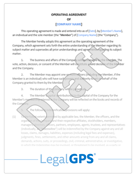The Ultimate Guide to Subordination Agreements
In the complex and dynamic world of business, financial contracts such as subordination agreements often lie at the heart of smooth operations and...
8 min read
LegalGPS : Oct. 5, 2024
Understanding contractual agreements is never simple. So, let's break it down. As an entrepreneur, having a handle on these agreements is like having a GPS for your business. An essential tool might just be a Contribution Agreement, especially when dealing with cash or assets.


Contribution Agreement (Cash or Assets)
Access our professional Contribution Agreement template for cash or assets. Streamline contributions in partnerships and joint ventures.
Trusted by 1,000+ businesses to safeguard their LLCs.
In the simplest terms, a Contribution Agreement is a legal document that manages the transfer of assets (cash, property, etc.) from one party to another, particularly in the business sphere. This contract is usually employed when businesses or individuals make a contribution to a project, partnership, or company in return for equity or shares.
The agreement can also be used for other types of contributions, such as services or time spent on a project. When should you use this agreement? If you’re planning to contribute cash or assets (property, equipment, etc.) to a project in return for equity or shares, then it’s highly recommended that you employ the help of an attorney and draft up a Contribution Agreement.
Every business transaction must be binding and protected. This is where a Contribution Agreement enters the scene. It's not just about putting things in black and white; it's about making sure everything is clear, precise, and enforceable. Here are some reasons why your business needs one:
Clarity: It provides a clear road map of what is being transferred, the value of the transfer, and the benefits for all involved parties.
Protection: It shields the parties involved from potential disputes or conflicts as it outlines specific terms and conditions.
Legal Compliance: It adheres to legal requirements and ensures the correct registration and reporting of the asset contribution.
Reassurance: It provides a sense of security and comfort to all parties involved in the transaction.
Clarity: It provides a clear road map of what is being transferred, the value of the transfer, and the benefits for all involved parties.
Protection: It shields the parties involved from potential disputes or conflicts as it outlines specific terms and conditions.
Legal Compliance: It adheres to legal requirements and ensures the correct registration and reporting of the asset contribution. Reassurance: It provides a sense of security and comfort to all parties involved in the transaction.
Navigating legal documents can be complex, but don't fret. Here's a breakdown of the common sections you might encounter:
Parties: This includes the names, addresses, and other details of each party. It may also include the type of business relationship (e.g., shareholder vs. partner) and a brief description of the company.
Property: This section describes any assets contributed to the company. It will include a description of the asset, its value, and whether it is subject to any liens or encumbrances (i.e., debts).
Consideration: This section outlines the value or price of the contribution, as well as payment terms and deadlines. The consideration may be a set amount of cash or an agreed-upon percentage of the company. It can also include an allocation of preferred stock shares, which give investors more control over the company's decisions than common stock does. If you're selling assets such as property or equipment, consider including a detailed description of those items in this section.
Representations and Warranties: This is where you'll find statements regarding ownership rights and other legal protections for both parties involved in the transaction. This might look like:
|
"The seller represents and warrants that he/she has the legal right to sell the assets described in this agreement and that no other person has any rights or interests in those assets." |
This section can also include statements regarding the condition of assets being sold, as well as any limitations on use.
Definitions and Interpretations: Contains technical terms and their definitions to reduce ambiguity. This is important because the language used in a contract can be confusing, and this section makes it clear what each party means by certain terms.
This might include definitions of words like “asset,” “title,” and other legal jargon you're not familiar with.
Contributions: Describes in detail the assets being transferred and their value. For example:
|
“The Seller hereby transfers to the Buyer, and the Buyer hereby accepts from the Seller, all of Seller’s right, title and interest in and to all property located at 123 Main Street, Anytown, USA.” |
Conditions Precedent: Outlines conditions that need to be fulfilled before the completion of an agreement. Moreover, it describes the consequences if these conditions are not fulfilled. For example:
|
“The Parties agree that they will enter into this Agreement on the date that all of the following conditions have been satisfied: (i) The Seller has received a check in the amount of $1,000,000 from Buyer; (ii) The Buyer has received a copy of all title policies and endorsements showing no outstanding encumbrances on said property; and (iii) An inspection has been completed by both parties and no material defects were found.” |
Warranties and Representations: Stipulations made by the contributing party about the status of the assets contributed. For example:
|
“The Seller warrants that it is the sole owner of the Property and has the right to convey title free of any encumbrances. This warranty shall survive for 90 days after the date this Agreement becomes effective.” |
Conditions Precedent: Stipulations made by both parties that must be fulfilled before any obligations under the contract become legally binding.
Dispute Resolution: Outlines the methods for resolution should disputes arise. This might include:
Mediation
Arbitration
Neutral Evaluation
Drafting any contractual document requires a considerable understanding of legal jargon and principles. Yet, with the right knowledge and guidance, it becomes more manageable:
To start, clarify who is involved in the agreement. This isn't just about names - you need to write down the full legal names of all parties, their commercial registration number (if any), registered office addresses, and types of entity (for instance, LLC, Corporation, etc.) Ensure to specify the party that is contributing the assets (the "Contributor") and the party receiving the contribution (the "Company").
Finance and Lending Agreements Guide
Now, let's tackle the asset at hand. You need to comprehensively detail the asset or cash being contributed. Avoid generalities. If it's a property, include its full address, size, and other relevant specifications. If it's cash, mention the exact amount. Then, assign a defined term to refer to these assets throughout the agreement, such as "Contribution".
For example, if the property is a house, you might include the following:
|
"Assets" include all real property owned by the company as of the date of this agreement, including but not limited to one (1) house located at 1600 Main Street, Austin, TX 78701." |
Next, you need to determine what the Contributor will receive in exchange for the assets. This could be shares, a membership interest, etc., in the Company. State the exact quantity and class of these securities and assign a defined term to refer to these, such as "Securities". This might look like:
|
"The Contributor will receive one-half (1/2) of the Company's common stock, which shall be valued at $5 per share, or a total of $10,000." |


Legal GPS Pro
Protect your business with our complete legal subscription service, designed by top startup attorneys.
You'll then need to detail any conditions precedent - things that must occur before the Contribution is made. These might include necessary approvals, accuracy of representations and warranties, or completion of due diligence. Example:
|
"The Company and the Contributor have each entered into this Agreement with the intention that it be effective upon execution. However, the Contributor's obligations under this Agreement will only become effective when all of the following conditions precedent are met: (1) The Contributors shall provide a representation letter to confirm that they are authorized to make such contribution; (2) The Board of Directors has approved this transaction in good faith; (3) There is no material adverse change in the business or operations of either party since signing this agreement." |
This section is essentially the Contributor promising certain facts about the Contribution. For example, the Contributor might warrant it owns the Contribution, it's not subject to any liens, and so on. Keep in mind, this clauses needs to be factual and accurate. Otherwise you run the risk of having a court find that you've misrepresented the truth.
This is especially important with software, since many courts will not read source code to determine whether or not it's in compliance. So be sure to get any warranties and representations in writing and signed off by both parties. For example:
|
"The Contributor represents that it owns the Contributions and that the Contributions are not subject to any liens or encumbrances." |
Now, you're at the point where you need to outline how and when the Contribution will be transferred to the Company. Determine if the transfer will happen all at once or in various stages. This might look like:
|
"The Transfer of Contributions is subject to the following conditions: (a) the Contributor must receive a written assignment from Company; (b) the Contributor must acknowledge and agree that its Contribution shall become part of the Work; (c) Company will provide Contributor with an appropriate form of acknowledgment for recordation with the appropriate governmental authority, if necessary; and (d) a statement will be included in the final documentation evidencing this transfer." |
This clause determines which state's laws will govern the interpretation of the agreement and where any lawsuits must be filed. Generally, this would be the state where your business is located. For example:
|
"This Agreement shall be governed by and construed in accordance with the laws of the State of Illinois, without giving effect to any principles of conflicts of law. Any action arising out of or relating to this Agreement shall be filed only in courts located in Cook County, Illinois." |
Don't skip this crucial step. Set out how disputes will be resolved, be it via mediation, arbitration, or court proceedings. A clearly detailed and agreed-upon process can save headaches down the road. Failure to do so might open you up to a number of legal challenges, as well as hurting your credibility with clients. For example:
|
"Any dispute arising out of or relating to this Agreement shall be settled by arbitration in accordance with the rules of the American Arbitration Association." |
Finally, at the end of the agreement, include space for the date and the parties' signatures, to finalize your Contribution Agreement.
Get Your Cash or Assets Contribution Agreement Template
with a Legal GPS Subscription
We learn from our mistakes. But in legal agreements, it's best to learn from others:
Inadequate or Vague Description of Asset: Make sure the description of the asset is detailed, precise, and leaves little room for confusion.
Neglecting Warranty Statements: Stressing on warranties ensures that all parties are starting from an informed position.
No Dispute Resolution: Avoid having a signed agreement without a clear dispute resolution process.
Failure to Consider Changes in Law or Technology: Make sure the agreement is designed to accommodate changes in technology and industry standards.
No Right of First Refusal: If you are providing an asset as part of your contribution, ensure that there is a right of first refusal for any potential buyers or new investors.
Failure to Include Assumption of Liabilities Clause: The assumption of liabilities clause ensures that all parties start from a similar legal position.
Running your business comes with many challenges, and one of those is navigating legalities. But with a roadmap that shows you the important aspects such as the Contribution Agreement for Cash or Assets, you're on the right path. Remember, every legal agreement is an asset for your business that provides clarities and protections.
Need a contribution agreement template? Get it right here. Simplify navigating through these complex waters with our handy template. Let them guide you through this journey!

Contribution Agreement (Cash or Assets)
Access our professional Contribution Agreement template for cash or assets. Streamline contributions in partnerships and joint ventures.
Trusted by 1,000+ businesses to safeguard their LLCs.
The biggest question now is, "Do I need a business lawyer?” For most businesses and in most cases, you don't need a lawyer to start your business. Instead, many business owners rely on Legal GPS Pro to help with legal issues.
Legal GPS Pro is your All-In-One Legal Toolkit for Businesses. Developed by top startup attorneys, Pro gives you access to 100+ expertly crafted templates including operating agreements, NDAs, and service agreements, and an interactive platform. All designed to protect your company and set it up for lasting success.
Get Legal GPS's Cash or Assets Contribution Agreement Template Now

Legal GPS Pro
Protect your business with our complete legal subscription service, designed by top startup attorneys.
|
Premium Template
Single-use Template |
Legal GPS Pro
Unlimited Access, Best Value |
|
|
| Choose Template | Learn More |
| Trusted by 1000+ businesses | |
Table of Contents

In the complex and dynamic world of business, financial contracts such as subordination agreements often lie at the heart of smooth operations and...

Navigating the financial ecosystem as a growing business can be challenging. However, with the right contracts on hand, like Junior Lender Friendly...

In the bustling world of entrepreneurship, financial security often comes tethered to careful measures. But what if there are still invisible...